

Forest School. Olive Tree Growers - Olive Tree Varieties - Arbequina, Frantoio, Koroneiki, Leccino, Manzanillo, Mission, Nicoise, Pendolino, Picaul. Olive trees make beautiful hedges Our Cast of Venerable Characters: *Arbequina *Arbosana *Chemlali *Coratina *Frantoio *Koroneiki *Leccino *Mission *Pendolino *Picual *Picholine *Santa Caterina *Seedling (Wild Olive) Arbequina 10 year old Arbequina tree A small tree (15').
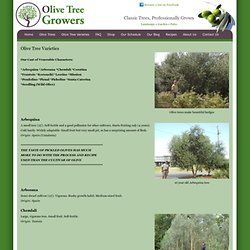
Arbosana Semi-dwarf cultivar (15'). Chemlali Chemlali. My Cology. Lauric acid. Lauric acid or systematically dodecanoic acid, the saturated fatty acid with a 12-carbon atom chain, thus falling into the medium chain fatty acids, is a white, powdery solid with a faint odor of bay oil or soap.
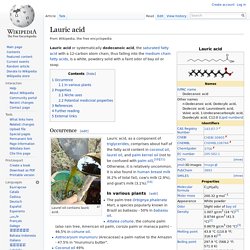
Occurrence[edit] Laurel oil contains lauric acid. Lauric acid, as a component of triglycerides, comprises about half of the fatty acid content in coconut oil, laurel oil, and palm kernel oil (not to be confused with palm oil),[10][11] Otherwise, it is relatively uncommon. It is also found in human breast milk (6.2% of total fat), cow's milk (2.9%), and goat's milk (3.1%).[10] In various plants[edit] Cohune oil. Cohune oil is pressed from the seeds of the cohune palm, which is native to Central and South America.
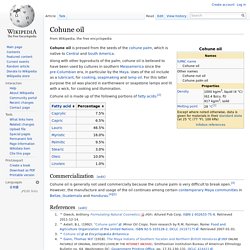
Along with other byproducts of the palm, cohune oil is believed to have been used by cultures in southern Mesoamerica since the pre-Columbian era, in particular by the Maya. Uses of the oil include as a lubricant, for cooking, soapmaking and lamp oil. For this latter purpose the oil was placed in earthenware or soapstone lamps and lit with a wick, for cooking and illumination. Cohune oil is made up of the following portions of fatty acids:[2] Commercialization[edit] Industrious Plants.
Tree Encyclopedia. Trees have three principle features that distinguish them from all other plants.
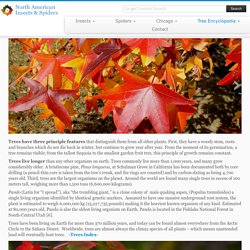
First, they have a woody stem, roots and branches which do not die back in winter, but continue to grow year after year. From the moment of its germination, a tree remains visible; from the tallest Sequoia to the smallest garden fruit tree, this principle of growth remains constant. Trees live longer than any other organism on earth. Tree Disease identification, symptoms, treatment options for tree diseases. There are many different diseases that affect landscape trees and shrubs.
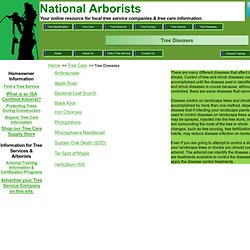
Control of tree and shrub diseases cannot be properly accomplished until the disease pest is identified. Identification of tree and shrub diseases is crucial because, although most diseases can be controlled, there are some diseases that cannot be controlled. Disease control on landscape trees and shrubs can sometimes be accomplished by more than one method, depending on the particular disease that if infecting your landscape plants. Tree Identification Guide at arborday. EXPLORE TREES. Best Tree Finder: Tree Wizard. International Society of Arboriculture. Genetic resources of agroforestry trees. I-Tree - Tools for Assessing and Managing Community Forests. Find Tree Service & Tree Removal Service Companies for Tree Work. US National Arboretum :. Society of American Foresters. Temperate Forest Farming & Permaculture Strategies. Permaculture Agroforestry.
Ma-Ke Bonsai of London and Online in UK. Welcome. European tree of the year. 6 Trees Every Survivalist Should Know & Why – Now is a good time to go out and flag the following six trees before the leaves drop (except the pine).
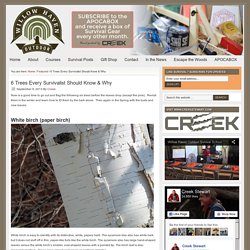
Revisit them in the winter and learn how to ID them by the bark alone. Then again in the Spring with the buds and new leaves. White birch is easy to identify with its distinctive, white, papery bark. The sycamore tree also has white bark, but it does not sluff off in thin, paper-like furls like the white birch. The sycamore also has large hand-shaped leaves versus the white birch’s smaller, oval-shaped leaves with a pointed tip. White birch survival uses: Sweet drinkable sap that does not need purificationContainers can be fashioned from the bark (and even canoes – hence the name “canoe birch”)It’s papery bark makes some of the finest fire starting tender on the planet, which will light even when damp because of its resinous qualityA fine tea can be made from the small twigs at the end of a branch or by shaving the bark from new growth. Basswood survival uses: White pine survival uses: Borassus flabellifer.
Borassus flabellifer, the Asian palmyra palm, toddy palm, sugar palm, or Cambodian palm, is native to the Indian subcontinent and Southeast Asia, including India, Bangladesh, Sri Lanka, Cambodia, Laos, Burma, Vietnam, Malaysia and Indonesia.

It is reportedly naturalized in Thailand, Malaysia, Mauritania, Socotra, and parts of China.[1] It is a palm tree, one of the sugar palm group. Description[edit] Borassus flabellifer is a robust tree and can live more than 100 years and reach a height of 30 metres (98 ft), with a canopy of green-bluish, leaves several dozen fronds spreading 3 m (9.8 ft) across. The very large trunk resembles that of the coconut tree and is ringed with leaf scars. Young palmyra palms grow slowly in the beginning but then grow faster with age. Fruit[edit] Main article: Palmyra fruit. The Fruit Tree Planting Foundation. Fruit Identification Outline. A.

Achene: Very small, one-seeded fruit, usually produced in clusters. At maturity the pericarp is dry and free from the internal seed, except at the placental attachment. This is the typical fruit of the largest plant family, the sunflower family (Compositae or Asteraceae). Examples of this type of fruit include the sunflower (Helianthus), buttercup (Ranunculus) and sycamore (Platanus). In the sycamore, the globose fruiting heads are composed of tiny, one-seeded achenes interspersed with hairs (some authors refer to these individual fruits as nutlets). B. C. D. Citrus ID: Home. Drupe. The development sequence of a typical drupe, a smooth-skinned (nectarine) type of peach (Prunus persica) over a 7 1⁄2 month period, from bud formation in early winter to fruit ripening in midsummer Other fleshy fruits may have a stony enclosure that comes from the seed coat surrounding the seed, but such fruits are not drupes.
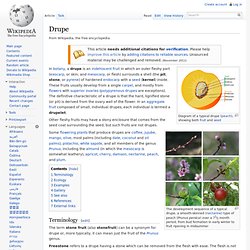
Some flowering plants that produce drupes are coffee, jujube, mango, olive, most palms (including date, coconut and oil palms), pistachio, white sapote, and all members of the genus Prunus, including the almond (in which the mesocarp is somewhat leathery), apricot, cherry, damson, nectarine, peach, and plum. Terminology[edit]
Palms of the World Online. Symptoms of Diseases and Disorders. Glossary of Palm Terms. Date Palms. 2000-Year-Old Date Pit Sprouts In Israel. Researchers confirm age of Methuselah tree. By Ari Rabinovitch JERUSALEM Thu Jun 12, 2008 9:19pm BST JERUSALEM (Reuters) - Israeli researchers who grew a sapling from a date seed found at the ancient fortress Masada said on Thursday the seed was about 2,000 years old and may help restore a species of biblical trees.

Carbon dating confirmed that the seed -- named Methuselah after the oldest person in the bible -- was the oldest ever brought back to life, Sarah Sallon, a researcher at the Hadassah Medical Centre in Jerusalem, reported in the journal Science. The seed came from the Judean date palm, a species that once flourished in the Jordan River Valley and has been extinct for centuries, Sallon said. It was one of a group discovered at Masada, a winter palace overlooking the Dead Sea built by King Herod in the 1st century BC.
The fortress was used by hundreds of Jewish insurgents in a revolt against Roman rule that erupted in 67 AD. "It has survived and flourished," Sallon said. (Editing by Alison Williams) The extinct tree which has resurrected from ancient seeds. For thousands of years, the date palm was a staple crop in the Kingdom of Judea, as it was a source of food, shelter and shade. Thick forests of the palms towering up to 80 feet and spreading for 7 miles covered the Jordan River valley from the Sea of Galilee in the north to the shores of the Dead Sea in the south. So valued was the tree that it became a recognized as a symbol of good fortune in Judea. It is chronicled in the Bible, Quran and ancient literature for its diverse powers, from an aphrodisiac to a contraceptive, and as a cure for a wide range of diseases including cancer, malaria and toothache.
However, its value was also the source of its demise and eventual extinction. The tree so defined the local economy that it became a prime resource for the invading Roman army to destroy. The ethnobotany of Christ's Thorn Jujube (Ziziphus spina-christi) in Israel. Lammas growth. Lammas growth on a pedunculate oak. Lammas growth, also called Lammas leaves, Lammas flush, second shoots, or summer shoots, is a season of renewed growth in some trees in temperate regions put on in July and August (if in the northern hemisphere, January and February if in the southern), that is around Lammas day, August 1, which is the Celtic harvest festival.
It can occur in both hardwoods and softwoods. Examples of common trees which exhibit regrowth are oak, ash, beech, sycamore, yew, scots pine, sitka spruce and hawthorn. This secondary growth may be an evolutionary strategy to compensate for leaf damage caused by insects during the spring.[1] It is not present in poplar, birch or willow. Birch sap. The simplest way to collect birch sap is to cut off a branch and let the sap drip into a bottle. Bottle of Russian commercial birch sap. Birch sap collection is done by tying a bottle to the tree, drilling a hole into its trunk and leading the sap to the bottle by a plastic tube. A small birch (trunk diameter about 15 cm) can produce up to 5 liters of sap per day, a larger tree (diameter 30 cm) up to 15 liters per day. Birch sap has to be collected in early spring before any green leaves have appeared, as in late spring it becomes bitter. The collection period is only about a month per year.
Birch sap may be consumed both fresh and naturally fermented. Birch sap can also be used as an ingredient in food or drinks, such as birch beer or wintergreen flavored candy. Ziziphus spina-christi. Ziziphus spina-christi, the Christ's Thorn Jujube is an evergreen tree native to northern and tropical Africa and southern and Western Asia. It grows in Israel in valleys up to an elevation of 500m.[1] Ziziphus spina-christi has significance to Jews[citation needed], Christians and Muslims, and is by some traditions the tree from which Jesus's Crown of Thorns was made.[2] The ripe fruits are edible[3] and the flowers are an important source of honey in Eritrea and Yemen.[4] References[edit] Ziziphus spina-christi in West African plants – A Photo Guide.
Other links[edit] Pistacia lentiscus. Pistacia lentiscus (also mastic; Greek: μαστίχα mastíkha ) is a dioecious evergreen shrub or small tree of the pistacio genus growing up to 4 m (13 ft) tall which is cultivated for its aromatic resin, mainly on the Greek island of Chios.[1] Description[edit] Pistacia lentiscus is a shrub or dioecious tree, with separate male and female plants, evergreen from 1 to 5 m high, with a strong smell of resin, growing in dry and rocky areas in Mediterranean Europe.
It resists heavy frosts and grows on all types of soils, and can grow well in limestone areas and even in salty or saline environments, making it more abundant near the sea. It is also found in woodlands, dehesas (almost deforested pasture areas), Kermes oak wood, oaks wood, garrigue, maquis, hills, gorges, canyons, and rocky hillsides of the entire Mediterranean area. The leaves are alternate, leathery, and compound paripinnate (no terminal leaflet) with five or six pairs[2] of deep-green leaflets. Distribution[edit] Resin[edit]
Buy Trees and Learn About Trees - Visit our Online Nursery. Buy affordable Giant Sequoia trees at arborday. Attributes: Buy affordable Tuliptree trees at arborday. Attributes: Buy affordable Dawn Redwood trees at arborday. Attributes: The world's 10 oldest living trees. Pir-e Herisht. Abarkuh. Pilgrimage in Zoroastrianism. Suggested prior reading: » Yazd Region Associated reading: » Udvada » Zoroastrian Places of Worship - Atash Bahrams The first part of the directions to Pir-e Herisht are the same as that for Pir-e Sabz. Angel Oak Tree - Angel Oak Tree - Angel Oak. 10 Oldest Trees in the World. Forests. TreeHugger. Forestry. Forestry.